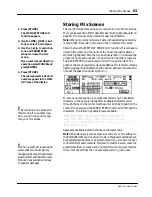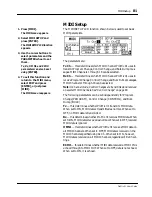
Processor Types
69
ProMix 01 User’s Guide
Compressor parameters are:
Threshold
(–40...+18dB) — This determines the level of input sig-
nal required to trigger the compressor. Signals at a level below the
threshold pass through unaffected. Signals at and above the threshold
level are compressed by the amount specified using the Ratio param-
eter. The trigger signal is sourced using the KEY IN parameter.
Ratio
(1:1–
∞
:1) — This determines the amount of compression.
That is, the change in output signal level relative to change in input
signal level. For a 2:1 ratio, for example, a 10dB change in input level
(above the threshold) results in a 5dB change in output level. For a
5:1 ratio, a 10dB change in input level (above the threshold) results
in a 2dB change in output level.
Compression ratios commonly used for vocals, piano, and bass range
from 2:1 to 6:1. A stereo mix maybe compressed 2:1 to add punch and
provide a more consistent volume level.
Attack
(0–120ms) This determines how soon the signal is com-
pressed once the compressor has been triggered. With a fast attack
time, the signal is compressed almost immediately. With a slow attack
time, however, the initial transient of a sound passes through unaf-
fected. Attack times from 1–5ms are a good place to start.
Release
(0.1–6.0s) — This determines how soon the compressor
returns to its normal gain once the trigger signal level drops below
the threshold. If the release time is too short, the gain will recover too
quickly causing level pumping (i.e. noticeable gain fluctuations). If it
is set too long, the compressor may not have time to recover before
the next high level signal appears, and it will be compressed incor-
rectly. Release times from 0.1–0.5s are a good place to start.
Out Gain
(–18...+18dB) — This sets the compressor’s output signal
level. Compression tends to reduce the average signal level. Out Gain
can be used to counter this level reduction and set an appropriate level
for the next stage in the audio path.
Limiter
A limiter is essentially a compressor with a high ratio setting. Com-
pression ratios above 10:1 are considered to limit signals rather than
compress them. When an input signal exceeds the specified threshold
level, its level is automatically reduced to the threshold level. This
means that the limiter’s output level never actually exceeds the thresh-
old level. Limiters are often used to prevent signals from overloading
amplifiers and tape recorders. A limiter with a relatively high thresh-
old, for example, could be patched into the stereo outputs to prevent
amplifier and speaker overload.
Limiter parameters are the same as those for the compressor.
-70 -60 -50 -40 -30 -20 -10 0 +10+20
-70
-60
-50
-40
-30
-20
-10
0
+10
+20
dB
dB
Output level
Input level
Compression
ratio = 2:1
Threshold = -10dB
-70 -60 -50 -40 -30 -20 -10 0 +10+20
-70
-60
-50
-40
-30
-20
-10
0
+10
+20
dB
dB
Output level
Input level
Compression
ratio = 10:1
Threshold = -20dB
Summary of Contents for Programmable Mixer 01
Page 4: ...ii ProMix 01 User s Guide...
Page 18: ...10 Chapter 1 Touring ProMix 01 ProMix 01 User s Guide...
Page 24: ...16 Chapter 2 User Interface ProMix 01 User s Guide...
Page 36: ...28 Chapter 3 Mixer Functions ProMix 01 User s Guide...
Page 68: ...60 Chapter 6 Groups and Pairs ProMix 01 User s Guide...
Page 74: ...66 Chapter 7 Scene Memories ProMix 01 User s Guide...
Page 96: ...88 Chapter 9 MIDI ProMix 01 User s Guide...
Page 102: ...94 Troubleshooting ProMix 01 User s Guide...
Page 116: ...108 Appendix ProMix 01 User s Guide...
Page 154: ...YAMAHA CORPORATION VS17170 IP 95 01 5000 AP Printed in Japan P O Box 1 Hamamatsu Japan...
















































